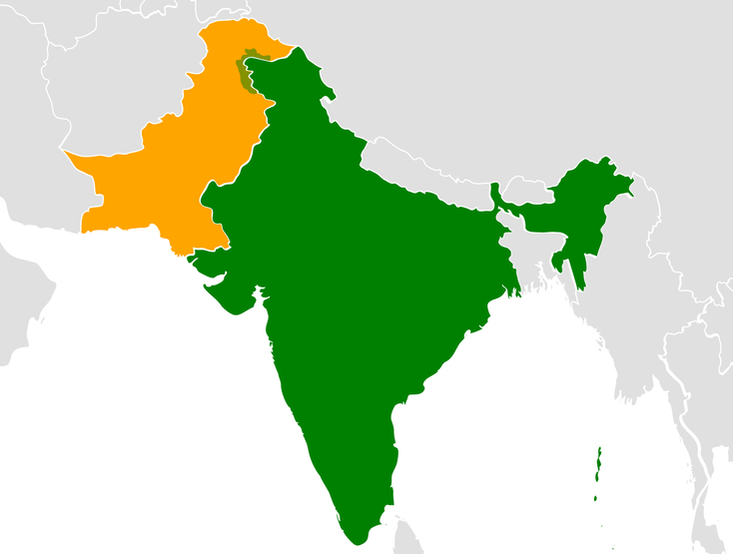|
A. Rabelo Context and Chinese involvement:
For decades the Kashmir region, between the borders of India, Pakistan and China, has been torn apart by war, conflict and death between India and Pakistan. The reason for such atrocities being committed goes back to the formation of Pakistan, when Muslims from India, fleeing persecution from Hindus after Britain left the country, found a safe haven in Pakistan. Since then, the two countries have become rivals in every possible aspect - from sports to military strength. But it is within the Kashmir region where most of the military conflict/competition between the two nations has occurred over the years. Conflicts between India and Pakistan have been so deadly over the years that in 1947, the war between the two countries led to the UN establishing the Line of Control (LOC) between the two countries in the Kashmir region, an internationally recognized border between India and Pakistan. While China, a global superpower, does share a border with the two countries via the Kashmir, Chinese President Xi Jinping does not want to involve his country in a conflict between the two rivals, as China has critical links with both India and Pakistan. Ties between China and India have recently strengthened in light of their increased trade, following China's trade war with the USA. Meanwhile, Pakistan is considered one of China’s closest economic, military and diplomatic allies in the region. Basically, China cannot afford to risk two important international links by getting involved in the Kashmir region in any way. Latest escalations: In early February 2019, a deadly attack on Indian military forces took place in Indian-controlled Kashmir, the deadliest attack on the nation’s military forces since the late 1980s. India has blamed the militant group Jaish-e-Mohammed (JeM) for this attack. The Hindu nation claims that the militant group has ties to Pakistan and Pakistani intelligence, saying that the rival nation had a “direct hand” in this deadly attack. Pakistan denies any involvement in such incident. On the 26th of February 2019, following the attack on India’s military, the Indian Air Force (IAF) launched airstrikes on key Pakistani positions inside Pakistan-controlled Kashmir. This was the first incursion of the LOC by Indian aircraft since the war of 1971 between the two countries. One day later, on the 27th of February, the Pakistani government announced that the Pakistani Air Force (PAF) shot down two IAF military fighter jets and captured one Indian pilot in response to the airstrikes carried out by IAF aircraft on the previous day. Indian authorities confirmed that only one pilot and one aircraft were missing and that other IAF aircraft show down a Pakistani jet in response to that loss. The IAF aircraft involved in this incident were reportedly Russian MiG-21 jets from the 1960s (one of which was shot down), and the PAF aircraft involved (according to some reports) were JF-17 Pakistani-made fighters, that shot down the Indian aircraft and an USA made F-16 fighter. According to several media reports, both pilots bailed-out of their respective aircraft, with Indian Wing Commander Abhinandan Varthaman being captured by Pakistani military personnel, and Pakistani Wing Commander Shahzaz-ud-Din having parachuted down to a village in Pakistani-controlled Kashmir. Locals reportedly lynched him, assuming he was an Indian pilot. After these events, several global powers such as the USA, the UK and China urged India and Pakistan to restrain from any further military action. Pakistani airspace was closed for several hours in the aftermath of the military activity, causing the disruption of several flights in the region. Pakistani PM Imran Khan and Indian PM Narendra Modi both called for dialogue. India demanded the release of the IAF pilot, warning Pakistan that such release was necessary and mandatory under the Geneva Conventions. Pakistani forces released a video of the Indian pilot saying that his captors had treated him well and, later, the Pakistani PM announced that the pilot would be released unharmed. Around the time that it was announced that Wing Commander Abhinandan Varthaman would be released, crowds gathered on both sides of the Wagah border, awaiting this token of peace and cooperation between two rival nations. Later, Varthaman was welcomed into India as a war hero. Now, the world waits to see what will happen next in this long tale of rivalry and conflict in Southern Asia.
1 Comment
Kathryn Jane Bancroft
3/14/2019 01:53:25 pm
This is wonderful Arthur, congratulations!
Reply
Leave a Reply. |
Categories
All
Archives
June 2024
|

